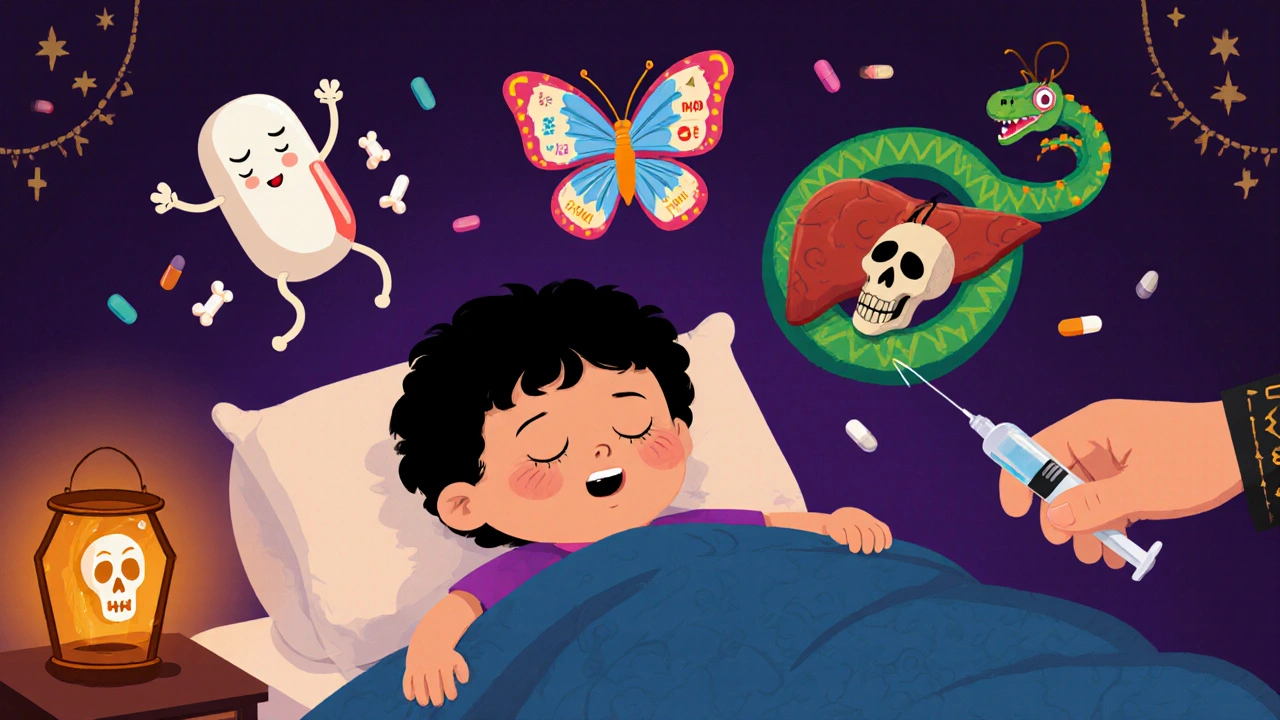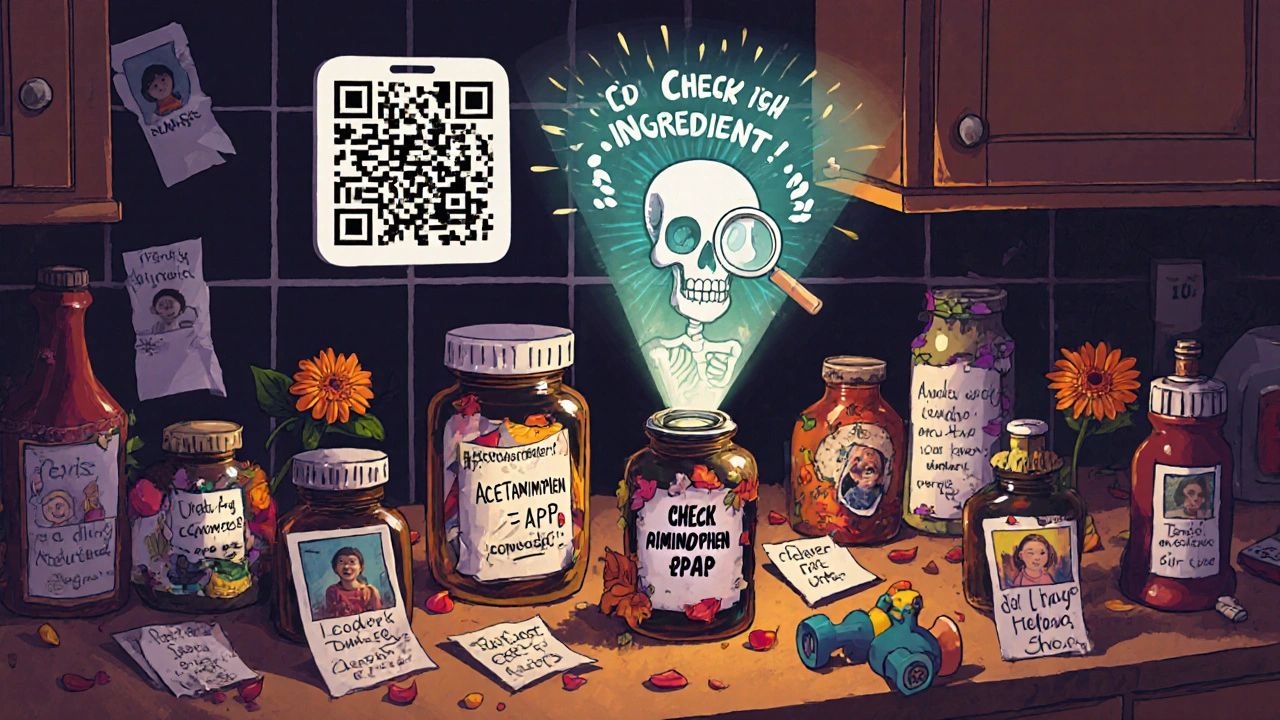Why Double Dosing Is a Silent Danger in Kids’ Medicine Cabinets
Every year, thousands of children end up in emergency rooms because someone gave them two medicines that looked different but contained the same active ingredient. It’s not a rare mistake-it’s shockingly common. Parents aren’t careless. They’re tired, overwhelmed, and trusting labels that don’t make it easy to spot the danger. The real problem? Acetaminophen is hiding in plain sight-in cold syrups, fever reducers, allergy meds, and even sleep aids. One parent gives Tylenol for fever. Another gives NyQuil for cough and runny nose. Both contain acetaminophen. The child gets two doses in six hours. And suddenly, liver damage is a real risk.
Children under 5 are at highest risk. Their bodies process medicines differently. A dose that’s safe for a 40-pound child could be toxic for a 20-pound toddler. Even a 10% overdose can double the chance of side effects. And it’s not just acetaminophen. Ibuprofen, diphenhydramine (Benadryl), and cough suppressants like dextromethorphan are just as dangerous when doubled. The American Academy of Pediatrics says 67% of these errors could be stopped with one simple habit: checking the active ingredient before giving any medicine.
What Exactly Is an Active Ingredient? (And Why It Matters More Than the Brand Name)
When you pick up a bottle of Children’s Motrin, you see “Ibuprofen” on the front. But when you flip it over, the tiny print says “Active Ingredient: Ibuprofen 100 mg per 5 mL.” That’s the key. The brand name doesn’t matter. The active ingredient does. Same goes for Children’s Tylenol, which contains acetaminophen-also called paracetamol, APAP, or N-acetyl-p-aminophenol. These are all the same chemical. If you give your child Tylenol and then a cold syrup labeled “Pediatric Cold & Flu,” and both list acetaminophen, you’re giving two doses of the same drug.
Here’s the hard truth: 73% of parents don’t realize that different brand names can mean the same active ingredient. NyQuil, Theraflu, Vicks DayQuil, and even some store-brand cold remedies all contain acetaminophen. One study found that 89% of multi-symptom cold medicines include it. That’s not a coincidence-it’s a design flaw in how these products are marketed. Parents think they’re giving “a cold medicine” and “a fever reducer,” not realizing they’re stacking two acetaminophen doses. And because acetaminophen overdose causes liver damage slowly-sometimes over 24 to 48 hours-many parents don’t realize what happened until it’s too late.
The Most Dangerous Active Ingredients in Kids’ Medicines
Not all active ingredients are created equal. Some have a tiny safety margin. A little too much, and the body can’t handle it. Here are the top three to watch for:
- Acetaminophen (APAP): Found in over 600 OTC products. Safe at 10-15 mg per kg of body weight every 4-6 hours. Over 150 mg/kg can cause liver failure. In kids under 6, it’s the leading cause of acute liver failure.
- Ibuprofen: Used for fever and pain. Safe at 5-10 mg/kg every 6-8 hours. Too much can cause stomach bleeding, kidney damage, or seizures.
- Diphenhydramine: Found in Benadryl, allergy meds, and sleep aids. Causes drowsiness. Double dose = extreme sleepiness, trouble breathing, or even coma in young kids.
ADHD meds like Adderall or Ritalin are also risky. Doubling a dose can spike heart rate by 20-30 beats per minute and raise blood pressure dangerously. Antidepressants like Prozac can trigger serotonin syndrome-fever, confusion, rapid heartbeat-if doubled. Even insulin, if accidentally given twice, can drop blood sugar fast enough to cause seizures in toddlers.

How to Check Active Ingredients Like a Pro (Step by Step)
There’s no magic trick. Just three steps, done every time:
- Look at the label, not the bottle. Ignore the brand name. Flip the bottle. Find the “Active Ingredients” section. It’s usually bolded and under a heading like “Drug Facts.”
- Write it down. Keep a small card or note in your phone: “Tylenol = acetaminophen,” “Motrin = ibuprofen,” “Benadryl = diphenhydramine.” Update it when you buy new meds.
- Compare before giving. Before giving any new medicine, ask: “Does this have the same active ingredient as something I already gave?” If yes, wait. Don’t give it.
Pro tip: Use the “ingredient first” method. Before buying any medicine, ask yourself: “What symptom am I trying to treat?” Then pick one medicine with just that ingredient. No combo packs. No “everything in one bottle.” Simple is safer.
Why Measuring Tools Matter More Than You Think
Even if you get the right ingredient, you can still overdose if you measure wrong. A teaspoon is not a tablespoon. A kitchen spoon is not a medicine spoon. The FDA says household spoons vary by up to 200% in volume. One parent’s “teaspoon” might be 2.5 ml. Another’s might be 7.5 ml. That’s a 3x difference.
Always use the measuring cup, dropper, or syringe that comes with the medicine. Never use a regular spoon. If the device is missing, ask the pharmacist for a new one. They’ll give you one for free. And never guess. If the dose is 5 mL, use the line marked “5 mL.” Don’t eyeball it.
What to Do If You Think You’ve Double Dosed
If you realize you gave your child two doses of the same medicine-especially acetaminophen or ibuprofen-don’t wait. Call Poison Control immediately: 1-800-222-1222. It’s free, confidential, and available 24/7. They’ll ask what medicine, how much, and when. Write that down before you call.
If your child is showing signs like vomiting, drowsiness, confusion, rapid breathing, or abdominal pain, go to the ER. Don’t wait. Liver damage from acetaminophen can take hours to show up, but treatment with N-acetylcysteine works best if given within 8 hours.

What Works: Real Strategies That Prevent Mistakes
Parents who stop double dosing don’t just rely on memory. They build systems.
- One person, one responsibility: Designate one adult to give all meds. If you’re a two-parent household, make a handoff chart. “I gave Tylenol at 2 PM. You handle the cough syrup at 6 PM.”
- Medication map: List every medicine in your cabinet. Write the active ingredient, strength, and last time given. Update it after every dose. One dad on BabyCenter said this cut his family’s errors to zero in six months.
- Use a pill tracker app: Apps like Medisafe or Round Health send alerts when it’s time to give a dose-and warn you if you’re about to give something with a duplicate ingredient. They’re not perfect, but they reduce risk by over 50%.
- Ask your pharmacist: When you pick up a new medicine, ask: “Is this safe with the other meds my child is taking?” Most pharmacists now print a dosing chart with active ingredients. Use it.
What’s Changing: New Rules and Tools to Help You
The system is slowly getting better. Starting in December 2025, all children’s OTC meds in the U.S. must list active ingredients in a standard format-with bold headings and no hidden names. That means “acetaminophen” will be spelled out, not hidden as “APAP.”
Some brands are already ahead. Johnson & Johnson and Procter & Gamble now put QR codes on packaging. Scan it, and you get a clear list of active ingredients and warnings. Amazon Pharmacy’s new “MedCheck” feature scans your cart and warns you if you’re buying two products with the same ingredient. In its first six months, it prevented 12,000 potential overdoses.
The American Academy of Pediatrics launched “Know Your Ingredients” in 2024, pushing for simple icons on packaging-like a red “X” over a duplicate ingredient. Pilot studies show it improves recognition by 57%.
Final Rule: When in Doubt, Don’t Give It
You don’t need to know every chemical name. You just need to know this: if you’re unsure whether two medicines have the same active ingredient, don’t give the second one. Wait. Call Poison Control. Ask your pediatrician. It’s better to wait an extra hour than risk a trip to the ER. Most kids who get double doses are fine if caught early. But many of those who aren’t caught-those who get liver damage or seizures-never had a second chance.
Check the ingredient. Write it down. Trust the label, not the brand. And remember: your child doesn’t need a medicine for every sniffle. Sometimes, rest and fluids are the best treatment of all.
What should I do if I accidentally give my child two doses of acetaminophen?
Call Poison Control at 1-800-222-1222 right away. Do not wait for symptoms. Acetaminophen overdose can damage the liver without showing signs for hours. If your child is vomiting, unusually sleepy, or has abdominal pain, go to the emergency room immediately. Treatment with N-acetylcysteine is most effective within 8 hours of overdose.
Can I give my child both Tylenol and Motrin for fever?
The American Academy of Family Physicians advises against alternating acetaminophen and ibuprofen in children under 3 years. It increases the risk of double dosing by 47%. If you need to alternate, use a written schedule and only do so under a doctor’s direction. For most fevers, one medicine is enough. Don’t combine them unless your pediatrician specifically says to.
Are store-brand medicines safer than name brands?
No. Store brands often contain the exact same active ingredients, strength, and dosage as name brands-sometimes from the same manufacturer. The only difference is price and packaging. Always check the “Active Ingredients” section. If both say “acetaminophen 160 mg per 5 mL,” they’re the same. Don’t assume one is safer.
Why do some medicines list “APAP” instead of “acetaminophen”?
APAP is a chemical abbreviation for acetaminophen (N-acetyl-p-aminophenol). It’s used to save space on labels, but it confuses parents. Until late 2025, manufacturers aren’t required to spell it out. Always look for APAP and treat it the same as acetaminophen. If you see it, count it as the same drug.
Is it safe to give cough medicine with fever medicine?
Only if you’ve checked the active ingredients. Most multi-symptom cold and cough medicines contain acetaminophen or ibuprofen. Giving them with a separate fever reducer means you’re giving two doses of the same drug. The CDC says 89% of these combination products contain acetaminophen. Avoid combo products unless you’re certain there’s no overlap.
How can I keep track of what my child has taken?
Keep a simple log: write the medicine name, active ingredient, dose, and time given. Use a notebook, phone note, or app like Medisafe. Update it after every dose. If two caregivers are involved, share the log. One parent’s “just a little” can be another’s full dose. Consistency prevents mistakes.
Jessica Correa
November 24, 2025 AT 00:25Don't trust the brand. Trust the ingredient.